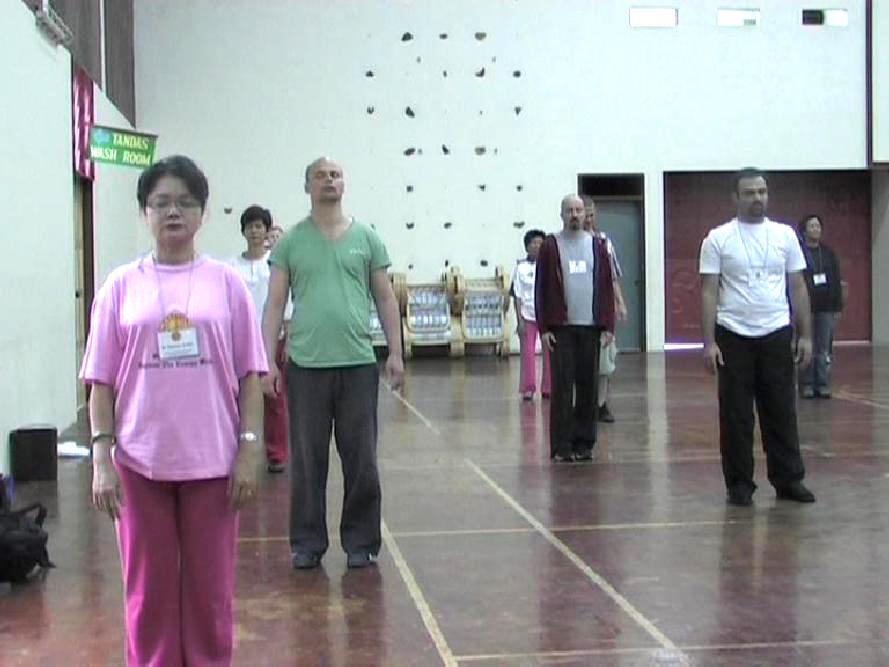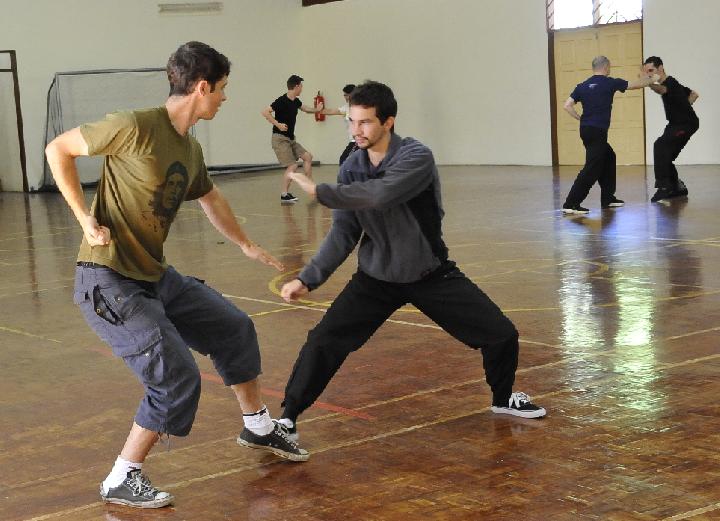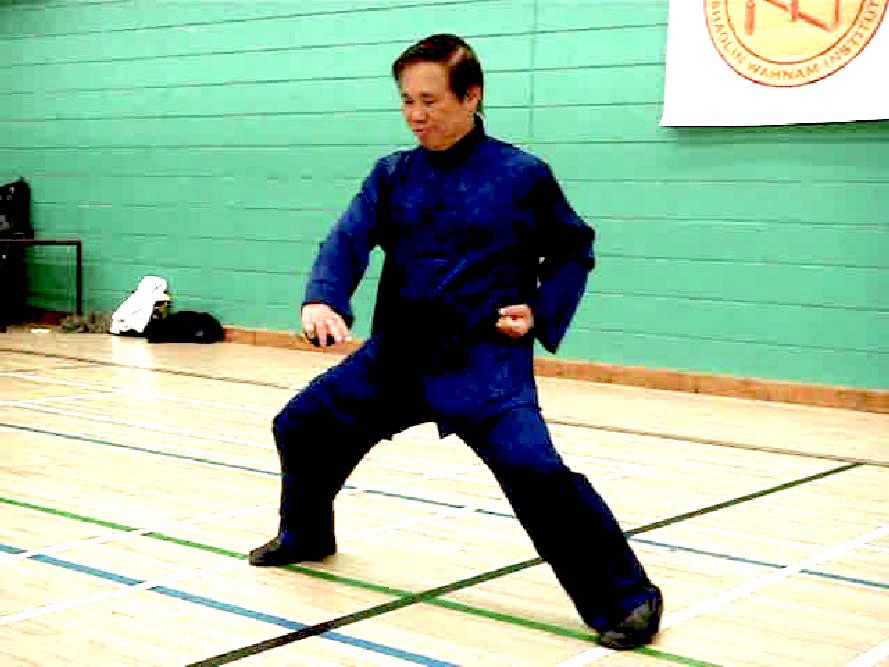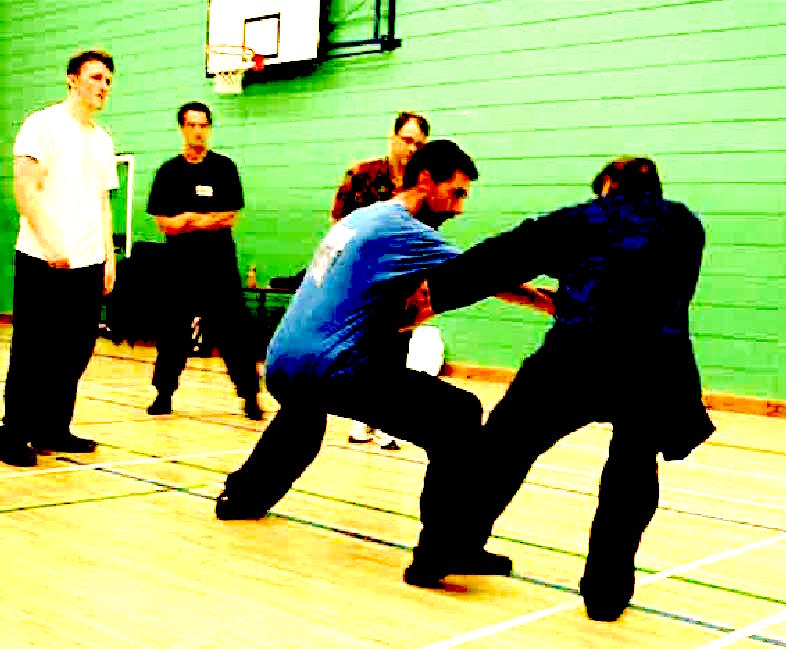SELECTION OF QUESTIONS AND ANSWERS
DECEMBER 2010 PART 2

Experiencing satori or spiritual awakening is not an uncommon occurance in our classes
Question 1
There is something I never fully understood, and it may be a result of faulty or inappropriate chi kung practice. Could doing kungfu movement, for example piquan from xingyiquan, develop so much energy in just one training session that it could overwhelm a comparatively frail body that had also been previously injured from contact sports like Taekwondo, Judo, as well as other injuries resulting from falls during military training?
Editorial Note
Richard's other questions are posted in
December 2010 Part 1
— Richard, Australia
Answer
Yes, it does. In force development it is of utmost importance to progress gradually. Over-training, even when you perform the techniques correctly, can be dangerous
Question 2
Some years ago, my teacher had me do piquan, and nothing else, for about half an hour. I got so engrossed that after a while, only piquan existed. The surroundings and even I weren't there. There was only the doing of piquan. After that round, my teacher took me aside and asked me to practice again, with the instruction "whole body let go, and anything don't think".
I did as he asked, and this time, piquan did itself, falling, floating, and falling; the movement and rhythm seemed as if nothing else existed. The body moved endlessly forward into infinity, just endless movement. When I stopped, part of me still felt as if I was moving forward endlessly.
The body was charged, alive, as if for the very first time; everything seemed clear, as if my eyes had been renewed. I could hear and feel the air around me as if it were water; if someone moved within twelve feet behind me, I could sense/feel him moving before I could hear him.
My arms and legs were heavy as lead, and the fingers and hands felt as if they could smash through walls or tear trees apart without effort. When I started to walk my legs felt as it they were helium-filled balloons, feeling oddly light when I moved and pleasantly heavy and rooted to the ground when I stopped. It was incredible. The feeling lasted the whole night. When I went to bed, I fell asleep instantly.
When I woke up, however, there was pain, aching and weakness everywhere, like the way the joints would ache when one was having a bad fever and cold, except that every injury I had had, ever since I was a child, was there; all the pain and weakness compounded. It hurt each time I was about to move. Actual physical movement hurt less than the moment just prior, when the body was on the verge of movement, but before it became visible.
And when I wasn't moving, there was that constant fatigue, feeling so tired, so sleepy, as if the body had been walking for days without food, water or rest, as was about to collapse. For about five weeks, all I wanted to do was sleep. It was the school holidays from university, and my parents thought I was just being lazy.
For a while, I thought they were right. I was just so tired, and it hurt to move, especially the knees, and whatever joint I had previously injured, including the little finger I had sprained in primary school. Each step was a mixture of pain, aching and fatigue, and I forced myself to move faster to overcome the discomfort, but that created very clumsy movements that made it look as if I was drunk. I was not. I just had no energy, and not much coordination. It was the complete opposite of what I had felt right after that evening's practice.
Answer
Thank you for your detailed account. This is very helpful to many people, including many of my students, who undergo deep cleansing. Particularly take note that deep cleansing clears out all injuries, including those that are very old.
You may not be aware of them, but old injuries logged deep inside your body insidiously affect your health and vitality. Clearing them out not only improves your health and vitality, but also enhances your longevity.
The earlier description of your spiritual experience, or satori, is illuminating. It confirms that what great spiritual and kungfu masters described in the past, like seeing the world as never before, and being so powerful to smash through walls, was true.
But you had built up so much energy that you physical body could not take it. It was excessive over-training.
It was also excessive cleansing. The energy went deep inside you and flushed out blockages that had been there long ago. It was too excessive for your comfort.
The concept of yin-yang would be useful to explain your situation.
Yin represents your physical body, and yang represents energy. At any one time yin or yang may be a bit more, but on the whole they should be balanced.
Suppose you start with 100,000 units of yin, and 100,000 units of yang. You are in harmony. After a good force training session, you increase your yang by 1000 units, making it 101,000.
This is fine as the increase is not drastic. But after a while your yang level will drop to 100,500, while your yin level rise to 100,500 too, maintaining yin-yang balance.
Where does your energy, 500 units of it, go to? Has it been wasted? No, it has been put to good use. Some of it is used in clearing blockage, and some in forming good cells to replace bad cells.
Will your physical body become bigger as a result of new healthy cells. You may, or you may not, depending on various factors. If you are already healthy, you may become slightly bigger as the new cells round up your body.
If you have a lot of blockage in your body, or a lot of unhealthy fats, your physical body may become slightly smaller as the result of cleansing. The difference, either way, is usually too minute to be seen.
If you practice consistently, you will progress gradually. Eventually your energy level will be many times than before. Will you also be many times bigger is size? No, your physical body will be many time more resilient.
However, if the increase of energy is too much at one time, then your physcial body would be unable to cope. Suppose you suddenly increase your energy level by 10,000 units, resulting in 110,000 units of yang and only 100, 000 units of yin.
This causes yin-yang disharmony. Your body will show signs of fatigue or pain as a safety precaution to enable you stop training and rest.

A sparring session during the Intensive Shaolin Kungfu Course in Sabah from 29th June to 5th July 2010
Question 3
When I felt more recovered I went back to my teacher and asked him about the fatigue and the knee/joint pain. He said that I should rest more, and apply the herbal 'die da' liniment that he gave me.
Because I had limited Mandarin vocabulary, I could not clearly describe what I was going through, and when I tried, I was not sure he could understand. I was politely trying to hint that the practice had some unusual effects but he seemed uncomprehendingly puzzled.
Later when I resumed practice, I dared not allow the mind to get that deeply engrossed and never allowed it to concentrate deeply during training.
No one I talked to could help me, not doctors of Chinese or Western medicine. I did not know what to do. I would hate to give up Chinese martial arts, but I do not know what other choices I have.
You have mentioned that any movement, be it chi kung or kungfu, can be practiced as chi kung, but that it should be practiced under proper supervision or it could lead to unwanted effects.
I have, whenever I could find suitable space, attempted Baguazhang movements as chi kung, according to the way you taught me during the chi kung course, including the chi flow, and it felt nice and pleasant. But I am a little hesitant about practicing piquan, or other kungfu movements again, unless I have your guidance. What should I do?
Answer
While you should not repeat the mistake of over-training, you need not be unduly worried over it. Though it caused some harm, the harm is not permanent and can be rectified. It was only a warning, and if you heeled the warning, which you did, it was alright.
More significantly, the benefit you obtained from the experience more than overshadowed the harm it had caused. You should therefore be thankful to your piquan teacher for the extraordinary experience, which has taught you three invaluable lessons.
The first lesson is that spiritual experiences are real, and you had a rare opportunity of experiencing one. The second lesson is how you may practice, when you are ready, to attain a similar experience, or even if you don't achieve a similar spiritual experience at least to improve your kungfu performance.
The key factor in attaining a spiritual experience is to attain no thought. In your case, you attained no thought through performing piquan to the exclusion of everything else. In my classes, some students attained no thought through some chi kung, Shaolin or Taijiquan exercises, or simply by not thinking of anything. In Zen monastries in the past, some monks attained no thought through meditation or gongans (koans).
The third lesson is over-training. The method your piquan teacher taught you was excellent, but you were not ready yet. You should be cleared of blockage first before generating a lot of energy, otherwise the excessive energy being locked in your body could cause much damage. But you need not worry as that was only one occasion. It could be dangerous if it was repeated many times.
You may wonder how you could develop so much energy by performing piquan alone. Probably you did your piquan mechanically, without being conscious of using any internal force training methods. The answer is found in what I have mentioned earlier. Form, breathing and mind generate energy flow in the ratio of 1, 3 and 6. When you practiced piguan in no thought, you generated a lot of energy.
What you need to do now is to perform more gentle chi kung exercises, like "Lifting the Sky" and "Carrying the Moon", to clear your blockage gradually. As you have less and less blockage, you can increase more and more energy.
How do you know when you have less and less blockage? This is an academic question, i.e. one asked by people who lack the experience. If you have the experience, you will know the answer. In other words, when you have less and less blockage, you will know it. In principle, it is the same as asking how you would know when you are full so that you could stop eating. You would know from direct experience.
Question 4
I am currently looking for work and hope to save enough money to attend either your Intensive Chi Kung or Intensive Shaolin Kungfu Course, whichever you think is more appropriate, and read your advice in May 2010 Part 2 and intend to follow it.
Answer
I believe that you will find attending my Intensive Chi Kung Course or Intensive Shaolin Kungfu Course to be one of the best things you have done. Ideally, you should first attend my Intensive Chi Kung Course, then about a year later my Intensive Shaolin Kungfu Course.
But our real world is not ideal. As there may be time and other constrains, I would recommend that you just attend my Intensive Shaolin Kungfu Course. Even at the course itself, you will experience many of the incrediable benefits you may have read about, like developing much internal force and mental clarity, and experiencing a tremendous sense of joy and freedom.

Grandmaster Wong demonstrates a pattern, "Single Planting of Flower", from the Triple-Stretch Set at the 2010 UK Summer Camp
Question 5
Ever since I stumbled onto chi kung last summer I'm really interested in it. I'm trying to read as much as possible and try to watch some videos as well.
— Mark, Netherland
Answer
While good books and good videos are very helpful, the onus of chi kung, or any art, is practical experience. No matter how much and how well you have read books or watched videos about chi kung, you can enjoy its benefits only if you practice it correctly and consistently. In other words, no amount of reading books and watching videos on chi kung can make you healthy and full of vitality.
This does not mean that reading books and watching videos are not beneficial. Amongst many benefits, good books and videos will show you how the art should be practiced, and will enable you to be cost-effective in your learning.
Question 6
I hold back trying to do it myself, since it is hard and potentially harmful to learn from books. I'm doing some of the Lohan forms on a form basis only and some with form and breathing. The only one I do with visualization is "Lifting the Sky".
Answer
It is not hard to learn and practice chi kung from good books or videos. Nevertheless, you have to follow the instructions respectfully. Advanced exercises, however, are best learnt from a competent teacher.
Many people have learnt from my books and have benefited a lot, including overcoming health problems that have troubled them for years. But when they learn from me personally at my Intensive Chi Kung Course, they find the difference incomparable.
If you practice on your own without the supervision of a teacher, it is best to leave out visualization.

Grandmaster Wong demonstrates a sophisticated application of "Single Planting of Flower" from the Triple-Stretch Set
Question 7
I couldn't find any information on the history of the Triple-Stretch Set. Would you mind providing a brief historical synopsis of the set?
— Andre, Canada
Answer
Not much is written about the Triple-Stretch Set though it is important because it is an exclusive set kept as top secret, particularly its force training method.
The original name of the Triple-Stretch Set was Great Majestic Set as it was taught by the abbot the Venerable Chee Seen (Zhi Shan in Mandarin) at the grand hall, known as the Great Majestic Hall, of the southern Shaolin Temple on Nine Lotus Mountain in Fujian Province of China. In Chinese, Triple-Stretch Set is called "Sam Chin Kune" (Cantonese) or "San Zhan Quan" (Mandarin), and Great Majestic Set is called "Tai Hoong Kuen" (Cantonese) or "Da Hung Quan" (Mandarin). The Venerable Sam Tuck and Hoong Hei Khoon, two of Chee Seen's best disciples, were expert in this set.
Chan Fook, who learned Shaolin Kungfu from the Venerable Harng Yein, the most senior disciple of the Venerable Chee Seen, brought the set out of the temple and taught it to Ng Yew Loong. Ng Yew Loong left China for Malaysia and taught this set to my sifu, Lai Chin Wah, who was better known by his honorable nickname Uncle Righteousness.
I did not learn the Great Majestic Set directly from Uncle Righteousness; I "stole" it while he was teaching my siheng, Wong Choy Wah. Stealing a set means learning it secretly while it is being demonstrated or taught to another person.
Later I learned another set, also called the Great Majestic Set, from another of my teachers, Sifu Ho Fatt Nam. This was called the Great Majestic Set too because it was taught at the Great Majestic Hall of the southern Shaolin Temple at the city of Quanzhou which is also in Fujian Province of South China. The two sets, however, were different. They were taught by different masters at the two different grand halls of the two southern Shaolin Temples, one on the Nine Lotus Mountain and the other at Quanzhou.
This Great Majestic Set from Sifu Ho Fatt Nam was not taught to me as a set at once as is normally done nowadays. The patterns were taught to me individually first. Then the various patterns were linked together into a set, and my sifu told me it was called the Great Majestic Set or "Tai Hoong Kuen", named after the Great Majestic Hall of the southern Shaolin Temple.
The first three patterns of this set, "One-Finger Shooting Zen", "Double Dragons Emerge from Sea" and "Poisonous Snake Shoots Venon", were taught to me as a force training routine, like what we do now in our "One-Finger Shooting Zen" routine in Shaolin Wahnam. The fourth pattern in our present routine, which is "Big Boss Offers Wine", is added by me from my training in Choe Family Wing Choon.
When I founded the Shaolin Wahnam Association in Sungai Petani about the year 1978, I taught the Great Majestic Set of Uncle Righteousness to Mogan, whose tremendous internal force many of our early Shaolin Wahnam members experienced when they met him at our first Intensive Shaolin Kungfu Course in the year 2000. In order not to confuse it with the Great Majestic Set of Sifu Ho Fatt Nam, I called it the Hoong Ka Triple-Stretch Set.
I used the term "Hoong Ka" because my classmates of Uncle Righteousness lineage had founded a school in honour of my sifu and called it Chin Wah Hoong Ka Academy, though my sifu did not use the term "Hoong Ka" but "Shaolin" instead. I called it "Triple-Stretch" because this was the main method practitioners of this set used to develop internal force. Interestingly, I learned this Triple-Stretch method to develop internal force from One-Finger Shooting Zen of Sifu Ho Fatt Nam.
The Triple-Stretch Set is also an important set in Choy-Li-Fatt Kungfu. I beleive it was taught by the Venerable Sam Tuck to the Venerable Cheng Choe, who in turn taught it to Chan Harng, the founder of Choy-Li-Fatt Kungfu. Understandably, as the two versions have passed through different masters over 150 years, the Choy-Li-Fatt version of Triple-Stretch is different from that we practice in Shaolin Wahnam.
Question 8
Can you please tell us something about the Iron-Wire Set?
Answer
The most famous master of the Iron-Wire Set was Thit Kiew Sam, which literally means "Iron-Bridge Three". This was his honorable nickname, his real name was Leong Khuen. He was called Iron-Bridge Three because his arms, called "bridges" in kungfu terns, were powerful like iron, and he was third in his family.
It was reputed that when he sat on the Horse-Riding Stance and extended his arms, five bulls on each side could not move them. Thit Kiew Sam developed such tremendous internal force by practicing the Iron-Wire Set.
I believe the Iron-Wire Set was invented by Thit Kiew Sam. I have not found any mention of this set before him. He must have drawn much inspiration from the Triple-Stretch Set, called the Great Majestic Set at the time, from his sifu, the Venerable Kwok Yun, who in turn learned it from the Venerable Sam Tuck.
Indeed, the principles and methodology of force development in Triple-Stretch and Iron-Wire are similar, though the pattern are different. Both generate energy flow, then transform the flowing energy into internal force. However, Iron-Wire is comparatively "harder".
Thit Kiew Sam greatly treasured a meeting with Hoong Hei Kwoon, who was the former's si-sook-kung, or kungfu grand-uncle. Thit Kiew Sam was in his youth and was amazed at the vitality and internal force of Hoong Hei Kwoon who was about 80 then. He sought the advice of the elderly master, who would have told him the secrets of the Triple-Stretch Set.
Thit Kiew Sam became very famous in kungfu circles. He was the most senior of the Ten Guangdong Tigers, the ten kungfu masters in south China noted for their kungfu abilities.
Thit Kiew Sam taught the Iron-Wire Set to Lam Fook Seng, who taught it to Wong Fei Hoong. Wong Fei Hoong taught it to Lam Sai Weng. Many Hoong Ka lineages today originated from Lam Sai Weng. The Iron-Wire Set is regarded as the most advanced set in Hoong Ka Kungfu, and is primarily used for developing internal force.
LINKS
Selected Reading
- Twelve Combat Sequences of Shaolin Tantui (Toronto)
- Shaolin Basic 16 Combat Sequences
- Understanding why Taijiquan comes from Wuji
- Is there Further Training after an Intensive Course?
- Abstinence from Sex?
